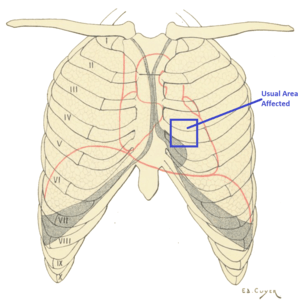Precordial catch syndrome
Precordial catch syndrome (PCS) is a non-serious condition in which there are sharp stabbing pains in the chest.[1] These typically get worse with breathing in and occur within a small area.[1] Spells of pain usually last less than a few minutes.[1] Typically it begins at rest and other symptoms are absent.[1] Concerns about the condition may result in anxiety.[1]
| Precordial catch syndrome | |
|---|---|
| Other names | Texidor's twinge[1] |
 | |
| One of the areas more commonly affected in precordial catch syndrome[1] | |
| Specialty | Pediatrics, family medicine |
| Symptoms | Sharp, stabbing chest pain in a small area[1] |
| Usual onset | Sudden[1] |
| Duration | Less than 3 minutes[1] |
| Causes | Unclear[1] |
| Differential diagnosis | Angina, pericarditis, pleurisy, chest trauma[1] |
| Treatment | Reassurance[1] |
| Prognosis | Good[1] |
| Frequency | Relatively common[1] |
The underlying cause is unclear.[1] Some believe the pain may be from the chest wall or irritation of an intercostal nerve.[1][2] Risk factors include psychological stress.[2] The pain is not due to the heart.[1] Diagnosis is based on the symptoms.[1] Other conditions that may produce similar symptoms include angina, pericarditis, pleurisy, and chest trauma.[1]
Treatment is usually via reassurance, as the pain generally resolves without any specific treatment.[1] Outcomes are good.[1] Precordial catch syndrome is relatively common, and children between the ages of 6 and 12 are most commonly affected.[1] Males and females are affected equally.[1] It is less common in adults.[2] The condition has been described since at least 1955.[1]
Signs and symptoms
Characteristic symptoms include sharp stabbing pains in the chest.[1] These typically get worse with breathing in and occur within a small area.[1] Spells of pain usually last less than a few minutes.[1] Typically it begins at rest and other symptoms are absent.[1] Concerns about the condition may result in anxiety.[1]
Causes
The underlying cause is unclear.[1] Some believe the pain may be from the chest wall or irritation of an intercostal nerve.[1][2] Risk factors include psychological stress.[2] The pain is not due to the heart.[1]
Treatment
Treatment is usually via reassurance, as the pain generally resolves without any specific treatment.[1] Occasionally it goes away after a couple of breaths.[1]
There is no known cure for PCS; however, PCS is not believed to be dangerous or life-threatening. Many see the worst part about PCS to be the fear that this chest pain is an indicator of a heart attack or other more serious condition. As the condition is not dangerous or life-threatening, there is no reason to take medication, although some people may choose to refrain from some normal activities such as physical exercise, as this can exaggerate the pain, particularly if it occurs during physical activity.
History
The syndrome was first described and named in 1893 by Henri Huchard,[3] a French cardiologist, who called it "précordialgie" (from the latin "praecordia" meaning "before the heart"), or "Syndrôme de Huchard" ("Huchard syndrome").[4][5] The term "precordial" had entered the French medical lexicon with the 1370 translation of Guy de Chauliac's Chirurgia magna.[6] Previously, the Latin term "praecordia" had been used to refer to the diaphragm, a sense now obsolete.[6][7]
The Huchard syndrome was then studied more deeply by Miller and Texidor, medical practitioners at the Cardiovascular Department and the Department of Medicine at the Michael Reese Hospital in Chicago, in 1955.[8] They reported the condition in 10 patients, one being Miller himself. In 1978, PCS was discussed by Sparrow and Bird who reported that 45 with it and that it was probably more frequent than generally assumed.[9] PCS in American children has been discussed by Pickering in 1981[10] and by Reynolds in 1989.[11] These constitute the literature available in English on PCS.
References
- Gumbiner CH (January 2003). "Precordial catch syndrome". Southern Medical Journal. 96 (1): 38–41. doi:10.1097/00007611-200301000-00011. PMID 12602711.
- McMorran, Jim. "Precordial catch syndrome (PCS)". General Practice Notebook. Retrieved 2 January 2018.
- Huchard, Henri (1844-1910) Auteur du texte (9 May 1893). "Traité clinique des maladies du coeur et des vaisseaux, par Henri Huchard,... Leçons de clinique et de thérapeutique, les cardiopathies artérielles, maladies de l'hypertension artérielle, maladies de l'hypertension artérielle, artério-sclérose généralisée, cardio-sclérose, aortites, angine de poitrine. 2e édition, entièrement remaniée" – via gallica.bnf.fr.
- Lefert, Paul (18-19 ) Auteur du texte. "Manuel du médecin praticien.... La pratique des maladies du coeur et de l'appareil circulatoire dans les hôpitaux de Paris, aide-mémoire et formulaire de thérapeutique appliquée / par le professeur Paul Lefert,..." – via gallica.bnf.fr.
- Huchard, H. (Henri) (9 May 1899). "Traité clinique des maladies du coeur et de l'aorte". Paris, Doin – via Internet Archive.
- "précordialgie". Centre National de Ressources Textuelles et Lexicales.
- "praecordia". Oxford Dictionaries.
- Miller, A.J.; Texidor, T.A. (December 1955). "Precordial catch, a neglected syndrome of precordial pain". Journal of the American Medical Association. 159 (14): 1364–5. doi:10.1001/jama.1955.02960310028012a. PMID 13271083.
- Sparrow MJ, Bird EL (October 1978). "'Precordial catch': a benign syndrome of chest pain in young persons". The New Zealand Medical Journal. 88 (622): 325–6. PMID 282484.
- Pickering D (May 1981). "Precordial catch syndrome". Archives of Disease in Childhood. 56 (5): 401–3. doi:10.1136/adc.56.5.401. PMC 1627421. PMID 7259265.
- Reynolds JL (October 1989). "Precordial catch syndrome in children". Southern Medical Journal. 82 (10): 1228–30. doi:10.1097/00007611-198910000-00007. PMID 2678498.